一般疑问句和否定句的变法
- 格式:ppt
- 大小:64.00 KB
- 文档页数:10
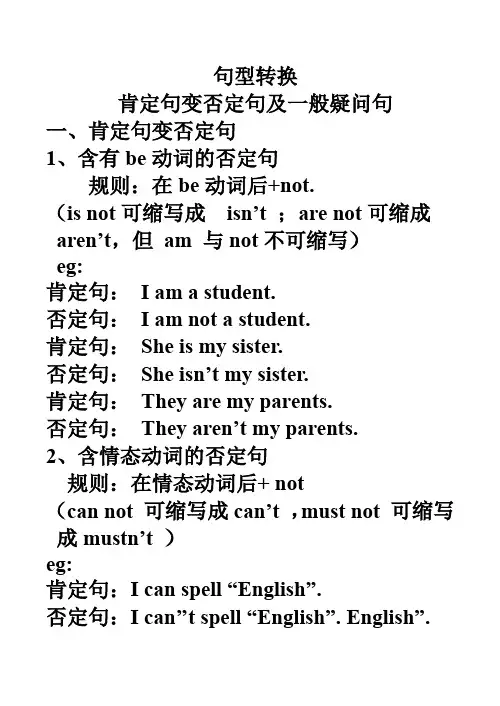
句型转换肯定句变否定句及一般疑问句一、肯定句变否定句1、含有be动词的否定句规则:在be动词后+not.(is not可缩写成isn’t ;are not可缩成aren’t,但am 与not不可缩写)eg:肯定句:I am a student.否定句:I am not a student.肯定句:She is my sister.否定句:She isn’t my sister.肯定句:They are my parents.否定句:They aren’t my parents.2、含情态动词的否定句规则:在情态动词后+ not(can not 可缩写成can’t ,must not 可缩写成mustn’t )eg:肯定句:I can spell “English”.否定句:I can’’t spell “English”.English”.肯定句:I must find it.否定句:I mustn’t find it.3、含有实义动词的句子的否定句构成(1)第三人称单数做主语。
(he、she、it或表示单个人或物的第三人称名词)规则:要在行为动词前加上助动词doesn’t,然后将动词恢复原形。
eg :肯定句:He has a soccer ball.否定句:He doesn’t have a soccer ball.(2)其它人称做主语规则:在行为动词前加don’t ,句子中的行为动词用原形。
eg:肯定句:They like bananas.否定句:They don’t like bananas.注:(1)在变否定句时,如遇some应变any Here are some books.Here aren’t any books.二、肯定句变一般疑问句1、含有be动词的句子变一般疑问句规则:把be动词提至句首,第一人称变第二人称,句末句号变问号。
(I/we变成youMy/our变成your)肯定句:I am a student.一般疑问句:Are you a student?肯定句:She is my sister.一般疑问句:Is she your sister?肯定句:They are my parents.一般疑问句:Are they your parents?2、含有情态动词的句子变一般疑问句规则:把情态动词提至句首,第一人称变第二人称,句末句号变问号。
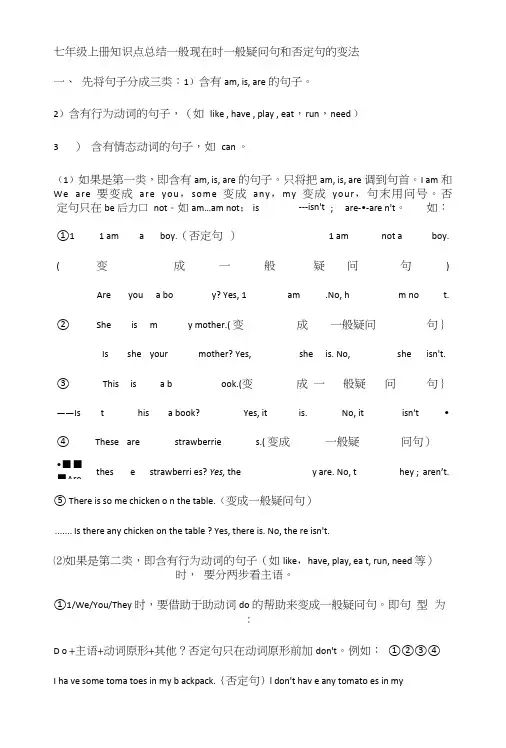
七年级上册知识点总结一般现在时一般疑问句和否定句的变法一、先将句子分成三类:1)含有am, is, are的句子。
2)含有行为动词的句子,(如like , have , play , eat,run,need )3 )含有情态动词的句子,如can 。
(1)如果是第一类,即含有am, is, are的句子。
只将把am, is, are调到句首。
I am和⑤ There is so me chicken o n the table.(变成一般疑问句)....... Is there any chicken on the table ? Yes, there is. No, the re isn't.⑵如果是第二类,即含有行为动词的句子(如like,have, play, ea t, run, need 等)时,要分两步看主语。
①1/We/You/They时,要借助于助动词do的帮助来变成一般疑问句。
即句型为:D o +主语+动词原形+其他?否定句只在动词原形前加don't。
例如:①②③④I ha ve some toma toes in my b ackpack.{否定句}l don't hav e any tomato es in mykpack.(变成一般疑问句}——Do you have any tomatoes in your backpa ck?Yes,Ido.No,Idon"t.We play sp orts every d ay.(否定句)一We don’t play sports ever y day. (变成一般疑问句卜-Do y ou play spor ts every day ? Yes, we do . No, we don’t.②He/She/It 时,要借助于助动词does 的帮助来变成一般疑问句。
即句型为: Does +主语+动词原形+其他?否定句只在动词前加does n't ,然后将单三还原 成原 形。
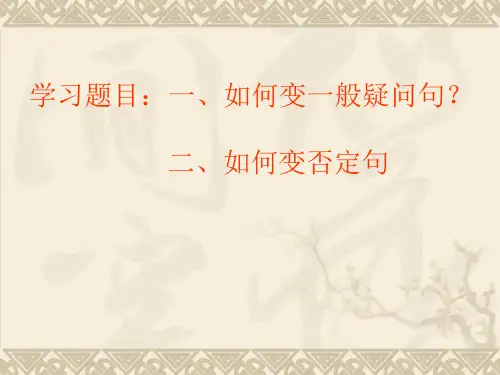
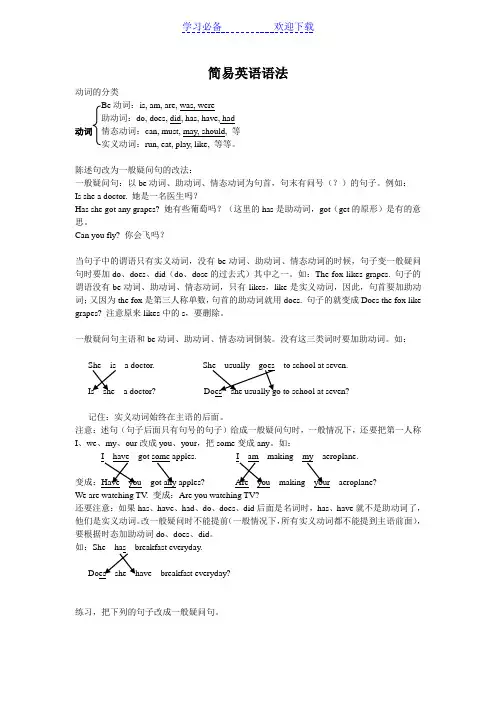
简易英语语法动词的分类Be动词:is, am, are, was, were助动词:do, does, did, has, have, had动词情态动词:can, must, may, should, 等实义动词:run, eat, play, like, 等等。
陈述句改为一般疑问句的改法:一般疑问句:以be动词、助动词、情态动词为句首,句末有问号(?)的句子。
例如:Is she a doctor. 她是一名医生吗?Has she got any grapes? 她有些葡萄吗?(这里的has是助动词,got(get的原形)是有的意思。
Can you fly? 你会飞吗?当句子中的谓语只有实义动词,没有be动词、助动词、情态动词的时候,句子变一般疑问句时要加do、does、did(do、dose的过去式)其中之一。
如:The fox likes grapes. 句子的谓语没有be动词、助动词、情态动词,只有likes,like是实义动词,因此,句首要加助动词;又因为the fox是第三人称单数,句首的助动词就用does. 句子的就变成Does the fox like grapes? 注意原来likes中的s,要删除。
一般疑问句主语和be动词、助动词、情态动词倒装。
没有这三类词时要加助动词。
如:She is a doctor. to school at seven.Is she a doctor? Does记住:实义动词始终在主语的后面。
注意:述句(句子后面只有句号的句子)给成一般疑问句时,一般情况下,还要把第一人称I、we、my、our改成you、your,把some变成any。
如:making变成:Have you got any apples? Are you your aeroplane?We are watching TV. 变成:Are you watching TV?还要注意:如果has、have、had、do、does、did后面是名词时,has、have就不是助动词了,他们是实义动词。
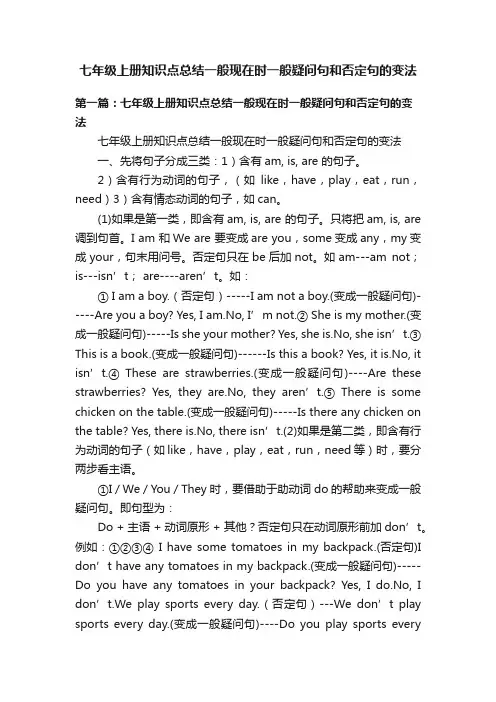
七年级上册知识点总结一般现在时一般疑问句和否定句的变法第一篇:七年级上册知识点总结一般现在时一般疑问句和否定句的变法七年级上册知识点总结一般现在时一般疑问句和否定句的变法一、先将句子分成三类:1)含有am, is, are 的句子。
2)含有行为动词的句子,(如like,have,play,eat,run,need)3)含有情态动词的句子,如can。
(1)如果是第一类,即含有am, is, are 的句子。
只将把am, is, are 调到句首。
I am 和We are 要变成are you,some变成any,my变成your,句末用问号。
否定句只在be后加not。
如am---am not;is---isn’t; are----aren’t。
如:① I am a boy.(否定句)-----I am not a boy.(变成一般疑问句)-----Are you a boy? Yes, I am.No, I’m not.② She is my moth er.(变成一般疑问句)-----Is she your mother? Yes, she is.No, she isn’t.③ This is a book.(变成一般疑问句)------Is this a book? Yes, it is.No, it isn’t.④ These are strawberries.(变成一般疑问句)----Are these strawberries? Yes, they are.No, they aren’t.⑤ There is some chicken on the table.(变成一般疑问句)-----Is there any chicken on the table? Yes, there is.No, there isn’t.(2)如果是第二类,即含有行为动词的句子(如like,have,play,eat,run,need等)时,要分两步看主语。
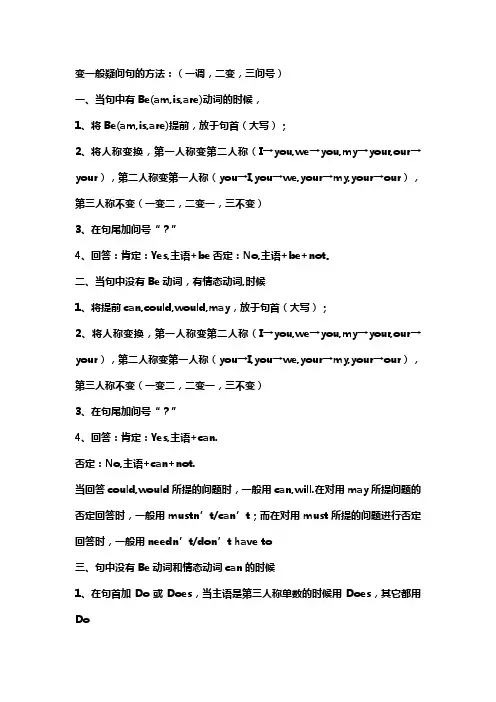
变一般疑问句的方法:(一调,二变,三问号)一、当句中有Be(am,is,are)动词的时候,1、将Be(am,is,are)提前,放于句首(大写);2、将人称变换,第一人称变第二人称(I→you,we→you,my→your,our→your),第二人称变第一人称(you→I,you→we,your→my,your→our),第三人称不变(一变二,二变一,三不变)3、在句尾加问号“?”4、回答:肯定:Yes,主语+be否定:No,主语+be+not。
二、当句中没有Be动词,有情态动词,时候1、将提前can,could,would,may,放于句首(大写);2、将人称变换,第一人称变第二人称(I→you,we→you,my→your,our→your),第二人称变第一人称(you→I,you→we,your→my,your→our),第三人称不变(一变二,二变一,三不变)3、在句尾加问号“?”4、回答:肯定:Yes,主语+can.否定:No,主语+can+not.当回答could,would所提的问题时,一般用can,will.在对用may所提问题的否定回答时,一般用mustn’t/can’t;而在对用must所提的问题进行否定回答时,一般用needn’t/don’t have to三、句中没有Be动词和情态动词can的时候1、在句首加Do或Does,当主语是第三人称单数的时候用Does,其它都用Do2、将人称变换,第一人称变第二人称(I→you,we→you,my→your,our→your),第二人称变第一人称(you→I,you→we,your→my,your→our),第三人称不变(一变二,二变一,三不变)3、在句尾加问号“?”4、回答:肯定:Yes,主语+do/does否定:No,主语+do/does+not.其它在句中要变换的词有some→any,am→are英语里只有三种人称:第一人称:我,我们,(I),we【me,us】(我),我们第二人称:你,你们,(you),you【you,you】(你),你们第三人称:他,她,它(he,she,it,)【him,her,it】他们they【them】还有一些人名也算第三人称,比如Kangkang,Jane.像your father(你的爸爸)这也算第三人称.第三人称单数指他(he)她(she)它(it)或者单个人名,第三人称复数是都用they他们/她们/它们此外,不可数名词在用法上也同于第三人称单数。
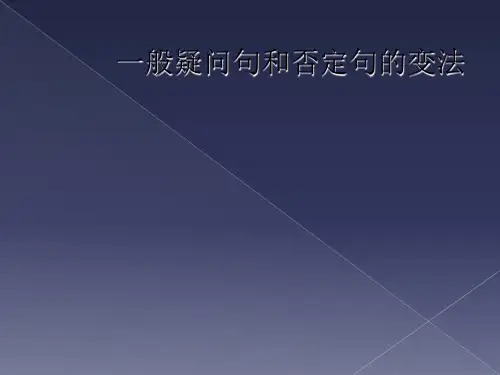
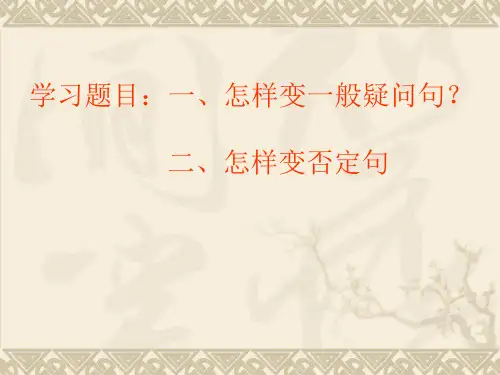
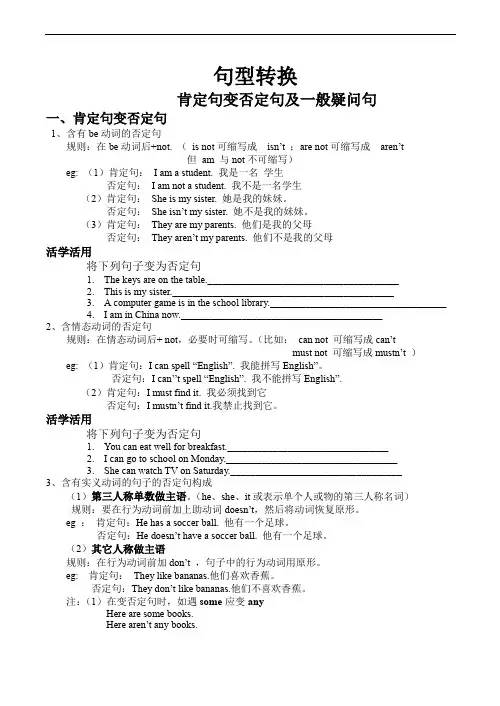
句型转换肯定句变否定句及一般疑问句一、肯定句变否定句1、含有be动词的否定句规则:在be动词后+not. (is not可缩写成isn’t ;are not可缩写成aren’t但am 与not不可缩写)eg: (1)肯定句:I am a student. 我是一名学生否定句:I am not a student. 我不是一名学生(2)肯定句:She is my sister. 她是我的妹妹。
否定句:She isn’t my sister. 她不是我的妹妹。
(3)肯定句:They are my parents. 他们是我的父母否定句:They aren’t my parents. 他们不是我的父母活学活用将下列句子变为否定句1.The keys are on the table.______________________________________2.This is my sister.____________________________________________3. A computer game is in the school library.___________________________________4.I am in China now.________________________________________2、含情态动词的否定句规则:在情态动词后+ not,必要时可缩写。
(比如:can not 可缩写成can’tmust not 可缩写成mustn’t )eg: (1)肯定句:I can spell “English”. 我能拼写English”。
否定句:I can’’t spell “English”.我不能拼写English”.(2)肯定句:I must find it. 我必须找到它否定句:I mustn’t find it.我禁止找到它。
活学活用将下列句子变为否定句1.You can eat well for breakfast.________________________________2.I can go to school on Monday.__________________________________3.She can watch TV on Saturday.__________________________________3、含有实义动词的句子的否定句构成(1)第三人称单数做主语。

简易英语语法动词的分类Be动词:is, am, are, was, were助动词:do, does, did, has, have, had动词情态动词:can, must, may, should, 等实义动词:run, eat, play, like, 等等。
陈述句改为一般疑问句的改法:一般疑问句:以be动词、助动词、情态动词为句首,句末有问号(?)的句子。
例如:Is she a doctor. 她是一名医生吗?Has she got any grapes? 她有些葡萄吗?(这里的has是助动词,got(get的原形)是有的意思。
Can you fly? 你会飞吗?当句子中的谓语只有实义动词,没有be动词、助动词、情态动词的时候,句子变一般疑问句时要加do、does、did(do、dose的过去式)其中之一。
如:The fox likes grapes. 句子的谓语没有be动词、助动词、情态动词,只有likes,like是实义动词,因此,句首要加助动词;又因为the fox是第三人称单数,句首的助动词就用does. 句子的就变成Does the fox like grapes? 注意原来likes中的s,要删除。
一般疑问句主语和be动词、助动词、情态动词倒装。
没有这三类词时要加助动词。
如:She is a doctor. to school at seven.Is she a doctor? Does记住:实义动词始终在主语的后面。
注意:述句(句子后面只有句号的句子)给成一般疑问句时,一般情况下,还要把第一人称I、we、my、our改成you、your,把some变成any。
如:making变成:Have you got any apples? Are you your aeroplane?We are watching TV. 变成:Are you watching TV?还要注意:如果has、have、had、do、does、did后面是名词时,has、have就不是助动词了,他们是实义动词。
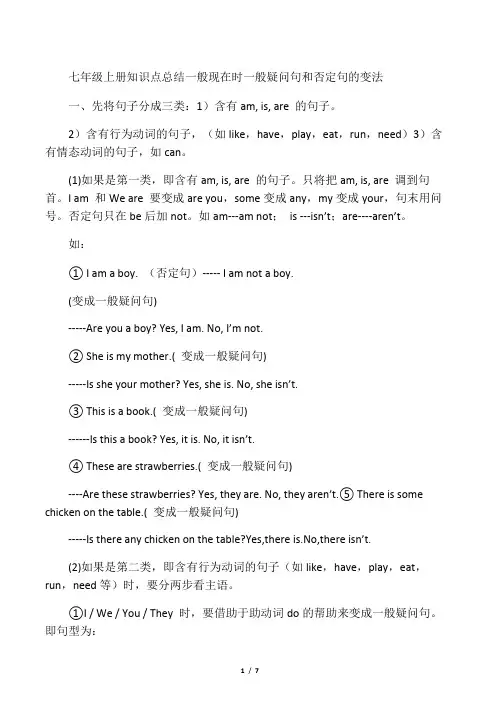
七年级上册知识点总结一般现在时一般疑问句和否定句的变法一、先将句子分成三类:1)含有am, is, are 的句子。
2)含有行为动词的句子,(如like,have,play,eat,run,need)3)含有情态动词的句子,如can。
(1)如果是第一类,即含有am, is, are 的句子。
只将把am, is, are 调到句首。
I am 和We are 要变成are you,some变成any,my变成your,句末用问号。
否定句只在be后加not。
如am---am not;is ---isn’t;are----aren’t。
如:① I am a boy. (否定句)----- I am not a boy.(变成一般疑问句)-----Are you a boy? Yes, I am. No, I’m not.② She is my mother.( 变成一般疑问句)-----Is she your mother? Yes, she is. No, she isn’t.③ This is a book.( 变成一般疑问句)------Is this a book? Yes, it is. No, it isn’t.④ These are strawberries.( 变成一般疑问句)----Are these strawberries? Yes, they are. No, they aren’t.⑤ There is some chicken on the table.( 变成一般疑问句)-----Is there any chic ken on the table?Yes,there is.No,there isn’t.(2)如果是第二类,即含有行为动词的句子(如like,have,play,eat,run,need等)时,要分两步看主语。
①I / We / You / They 时,要借助于助动词do的帮助来变成一般疑问句。
英语否定句和一般疑问句改写口诀《英语否定句和一般疑问句改写口诀一》小朋友们听仔细,否定句呀有奥秘。
一找动词是第一,就像寻找小宝贝。
如果动词是be词,直接后面加not字。
好比给它戴个帽,否定意思就来到。
若是实意动词在,助动词来把忙帮。
do或者does上场,这个规则要记详。
原来动词要还原,就像玩具放回仓。
一般疑问句也不难,be动词先到最前端。
就像士兵站排头,后面跟着那主宾。
实意动词要发问,助动词就向前奔。
语序调整别混乱,就像排队站得端。
《英语否定句和一般疑问句改写口诀二》否定句改写不用慌,一观句子结构强。
若是be动词现形,not紧跟莫要忘。
这就如同加把锁,否定意义锁住了。
遇到行为动词时,do或does来加持。
否定词not随后缀,动词变回原样子。
好比魔法被撤销,最初模样才对味。
再说一般疑问句,be动词提前要牢记。
如同火车头在前,拉着车厢跑向前。
要是实意动词句,助动词开头来领路。
主语乖乖后面跟,语序就像走正步。
《英语否定句和一般疑问句改写口诀三》改写否定有诀窍,首先来把动词瞧。
be动词它很乖巧,not加上就否定掉。
如同给画遮块布,原来意思被挡住。
要是动词为实意,do does来处理。
not就像小尾巴,贴在后面笑嘻嘻。
动词变回最初形,就像树叶落回地。
一般疑问句也妙,be动词提前来报道。
好像小鸟先出巢,后面跟着伙伴鸟。
实意动词的句子,助动词先行来开道。
句子顺序安排好,整齐就像列早操。
《英语否定句和一般疑问句改写口诀四》否定句呀要写对,动词类别先归类。
be动词在句中睡,not一添就到位。
好似给星遮光辉,否定之意在周围。
遇到实意动词堆,助动词得把场归。
do does来做守卫,not紧跟别掉队。
动词还原像回归,原位才是它的队。
一般疑问句不难会,be动词跑到首位。
如同班长站首位,带着全班齐步退。
实意动词的语句,助动词向前迈大步。
主谓顺序不糊涂,就像桥搭得牢固。
《英语否定句和一般疑问句改写口诀五》小朋友们来听讲,否定句改有良方。
句型转换肯定句变否定句及一般疑问句一、肯定句变否定句1、含有be动词的否定句规则:在be动词后+not. (is not可缩写成isn’t ;are not可缩写成aren’t但am 与not不可缩写)eg: (1)肯定句:I am a student. 我是一名学生否定句:I am not a student. 我不是一名学生(2)肯定句:She is my sister. 她是我的妹妹。
否定句:She isn’t my sister. 她不是我的妹妹。
(3)肯定句:They are my parents. 他们是我的父母否定句:They aren’t my parents. 他们不是我的父母活学活用将下列句子变为否定句1.The keys are on the table.______________________________________2.This is my sister.____________________________________________3. A computer game is in the school library.___________________________________4.I am in China now.________________________________________2、含情态动词的否定句规则:在情态动词后+ not,必要时可缩写。
(比如:can not 可缩写成can’tmust not 可缩写成mustn’t )eg: (1)肯定句:I can spell “English”. 我能拼写English”。
否定句:I can’’t spell “English”.我不能拼写English”.(2)肯定句:I must find it. 我必须找到它否定句:I mustn’t find it.我禁止找到它。
活学活用将下列句子变为否定句1.You can eat well for breakfast.________________________________2.I can go to school on Monday.__________________________________3.She can watch TV on Saturday.__________________________________3、含有实义动词的句子的否定句构成(1)第三人称单数做主语。
句型转换:一般疑问句、否定句的变化规律要点精析一、陈述句该为一般疑问句或是否定句的变化规律1.当句中有be动词(am,is are)时,改成否定句时,在be动词后加not;改成一般疑问句时,把2.I would like to have some milk. (改成一般疑问句) ——————————————————————————3.They often go to the library on the weekend.( 改成一般疑问句) ——————————————————————————4.My friend go to school on foot. (改为否定句)——————————————————————————5.I am going to do my homework tomorrow.( 改成一般疑问句) ——————————————————————————6.Please read Lesson One.(改为否定句)_________ __________ Lesson One,please.7.Jackie has lunch at schoo1.(改为一般疑问句)_________ Jackie __________ lunch at school ?8. They go to bed early.(改为一般疑问句)________ they ________ to bed early?9. Mike does well in English. (改为否定句)Mike _______ _______ well in English.10.u Hai and Su Yang look the same.(改为一般疑问句)_______ Su Hai and Su Yang _______ the same?11. They studied at Guangzhou International school.(改为一般疑问句) _______ they _______ at Guangzhou International school?12. There is some water in the bottle.(改为一般疑问句)_______ there _______ water in the bottle?2.用情态动词的情况下有特殊情况。